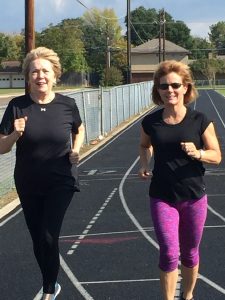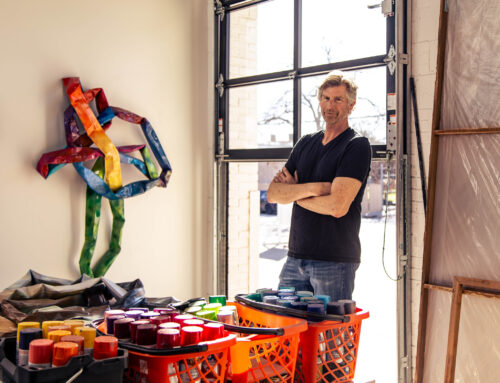 A few months ago, I hosted a breakfast gathering at my house for members of my Pilates class. I have been taking this class at the Town North YMCA for the past seven years and this group of women has motivated me and kept me interested in attaining better health. The fascinating thing about the group is that our ages span five decades…the youngest is 41 and the oldest is 81. These women are an important part of my life—my healthy life.
A few months ago, I hosted a breakfast gathering at my house for members of my Pilates class. I have been taking this class at the Town North YMCA for the past seven years and this group of women has motivated me and kept me interested in attaining better health. The fascinating thing about the group is that our ages span five decades…the youngest is 41 and the oldest is 81. These women are an important part of my life—my healthy life.
I was always active but I hardly ever made much time to workout, especially when I was working full time in the corporate world even though I knew it was important and it was supposed to be good for me. I would go in and out of exercising but I didn’t have a consistent program. I decided I needed to get healthier considering my mother had died of cardiovascular disease at the young age of 48. One thing I knew for sure is that I wanted to be around to see my son grow up, marry and have children, which unfortunately my mother didn’t get to do with all of her children.
I read a book called Blue Zones by Dan Buettnner that covers “lessons for living longer from the people who’ve lived the longest”. Between the book, my Pilates class, discussions with my walking partner, Jan, and my good friend and neighbor, Patsy Shropshire, PT DPT, I began to understand the necessity of keeping fit, eating right and belonging to a group that helps to motivate me to living a healthier life-style.
Patsy is a doctor of physical therapy and has been a physical therapist for more than 30 years. She runs WWB Wellness, a community wellness program geared for women primarily in their 50s and 60s. With WWB, 20 ladies come together three days a week for exercise and education and work on strength, endurance, flexibility, posture, balance, and agility. Patsy says, “Sometimes we laugh more before 7am than most people do in an entire day. Our group has a great sense of camaraderie.”
The simplicity of what Patsy is accomplishing with this program rings true with the premise of the Blue Zones book where the combination of a healthy lifestyle, a good diet and the company you keep can help you live not just longer, but with higher quality.
I sat down with Patsy to talk about the health benefits of exercise at any age.
LL: What’s the best age to start exercising?
PMS: We were practically born exercising, only it was cleverly disguised as play time! If you ever had difficulty changing the diaper of a 6-month-old because the baby was having too much fun kicking his legs at lightening-speed, you know what I mean. And perhaps when the baby stopped kicking, he went into a perfect Happy Baby yoga pose. The human body was meant to move on a daily basis. The more important questions are ‘When and why did we ever stop exercising, and how do we get back at it?’
LL: If a person has never exercised can they start at any age?
PMS: It’s never too late to start, just know that today is better than tomorrow. There are many examples of people in their 60s and up who begin exercise and reap great benefits. Look at Pat Matyastik. She’s 68, had little prior exposure to exercise, and, after four months of working out, her One-Mile Walk Test has improved by almost two minutes. This is meaningful because there’s a strong correlation between faster walking speed and a higher quality of life for seniors. She’s nearly doubled the amount of pushups she can do in one minute, and that’s awesome, because greater strength means greater independence.
LL: What’s the best way to start exercising, especially if you’ve never done it before?
PMS: Start exercising with the appropriate amount of guidance. A 25-year-old with no medical history who had an athletic childhood needs little to no guidance. A 48-year-old obese, hypertensive person with back pain needs much guidance. Google the PAR-Q form; the 7 simple questions provide a starting point for determining exercise readiness.
LL: If someone has been injured or has a chronic medical condition like a stroke, what can be done to help the person get back to optimum health?
PMS: The key is to have a thorough wellness evaluation by a physical therapist, which will provide a clear picture of how your medical history affects your movement. From that evaluation, the PT can write an appropriate, challenging exercise prescription. The more challenging your medical history, the more involved a PT should be in your program.
Physical therapists not only treat those with injuries/issues, but they play a huge part in teaching how to prevent medical events. Prevention is, hands down, easier and more enjoyable than treatment.
LL: As we age, what will happen if we don’t exercise?
PMS: Besides the obvious weight gain, consider this: muscles atrophy; ligaments and tendons lose elasticity; bones become more porous; the heart pumps less blood per heartbeat; arteries stiffen; lung capacity decreases, potential for arthritis and certain cancers rise, balance/agility skills plummet; potential for depression increases, and with today’s studies on neurogenesis, brain atrophy can be added to the list. Inactivity is a painful, sad picture.
LL: Before starting an exercise program what steps should be taken?
PMS: Have a PT wellness evaluation so you can identify your strengths and weaknesses. This is different than the physical with the physician. The physical is important, but doesn’t always cover all the bases. Who’s testing your posture, strength, flexibility, percent body fat, endurance, agility, and balance? Who’s discussing eating and sleeping habits and stress levels with you? These things are examined in the wellness evaluation and are important for your quality of life. Then, have the wellness evaluation repeated annually to see if you’re training effectively. Complex problems face this country but, truthfully, health care shouldn’t be one of them. The answer is simple. Exercise, eat real food, and have loving people around you that make you want to get out of bed and do some good. If you’re having wellness issues, if you’re inactive and unhappy, it’s time to be brave. Reinvent yourself. Somewhere, deep down, there’s a little bit of “athlete” in you just waiting to bust loose. Pat Matyastik reinvented herself, and she’s happier and “younger” today than she was ten years ago.






